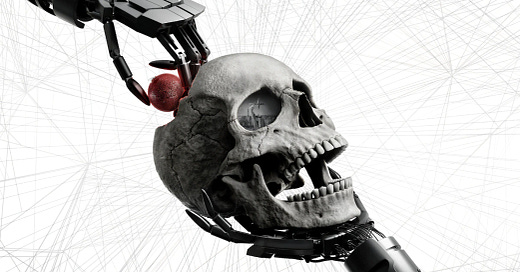From The Sims & Westworld, To Our World
The Exciting Future of Generative Agents, Robotics, and Synthetic Biology
Hello and welcome to the first edition of AI-Fi. You can read more about this newsletter on the about page.
If you haven't heard, ChatGPT was recently used by researchers at Google and Stanford to create human-like characters in a simulated world called Smallville. This world is reminiscent of a video game, with 25 preloaded characters who carry out various activities like sleeping, cooking, socializing, and attending parties to mimic human behavior. While some have compared this experiment to the TV show Westworld, it's important to note that the characters' actions and dialogue are generated by AI, much like in a video game demo.

The research team behind Smallville employed an intriguing method to create human-like characters in a video game-like world. Using ChatGPT, they input one paragraph per character, detailing their occupation, relationships with others, and past experiences. They then started the simulation, which they called an "Interactive Simulacra of Human Behavior."
What makes these generative agents unique is their ability to retrieve information from their memory - a comprehensive record of their experiences - and use it to determine actions and make decisions. Additionally, they can reflect and create new insights, which allows them to make long-term plans.
After running the simulation for a while, the researchers "interviewed" each character and found that some of them had developed their own careers and interests. For instance, Sam, one of the characters, decided to run for mayor after being "involved in local politics for years." He shared his plans with other AI agents, and the researchers observed how this news spread throughout the town. Klaus Mueller, another agent, was "researching the effects of gentrification in low-income communities for a research paper."
This experiment showcases the potential of generative AI to create intelligent agents that can make decisions and develop their own goals and aspirations.
Here’s the link to the main article.
Westworld Coming to Life
So, the recent article we discussed on Generative Agents got me thinking and I recollected the hit TV show Westworld, where lifelike robots interacted with human guests in a futuristic theme park in the first few seasons? Remember? If you haven’t watched Westworld and you’re an AI-Robot fan, check this trailer out:
The show's plot became more intriguing in season 3 and 4, as Dolores (played by Christina) seemingly went god-mode and started working as a writer at Olympiad Entertainment, creating stories for what she believed were non-player characters in video games. The character's agency and power over the fictional characters' lives and experiences reflected the increasing influence of technology on the entertainment industry.
But the show didn't stop there in its exploration of technology's capabilities. Rehoboam, the predictive AI, predicted and planned the future of humanity via control of every individual's life and behaviors. While the technology depicted in the show seemed far-fetched at the time, recent developments suggest we may be getting closer than we think. With the rise of big data and predictive algorithms, it's not difficult to imagine a future where an AI like Rehoboam could wield immense power over our daily lives, shaping our choices and even our destinies. The show's depiction of a dystopian future where technology reigns supreme serves as a cautionary tale of the importance of understanding and regulating the development of emerging technologies.
In fact, just a few months after the release of GPT-4 and during the past week, Language Models have hit a major milestone with the development of "generative agents" that can simulate human-like decision-making in an interactive sandbox inspired by The Sims. Generative agents use a three-component architecture that enables them to store a complete record of their experiences using natural language, synthesize those memories over time into higher-level reflections, and dynamically retrieve them to plan behavior.
Now the question is, just how advanced are these generative agents? According to a recent study, a generative agent trained on a variety of tasks was able to achieve human-level performance on a task it had never seen before. In another study, generative agents were shown to outperform humans in a real-time strategy game. These results suggest that generative agents have the potential to not only simulate human-like behavior but also to exceed human capabilities in certain domains.
This breakthrough has significant implications for the future of AI and robotics. Layering this technology on top of Boston Dynamics robots, for example, could pave the way for even more lifelike and autonomous machines. And it's not just science fiction anymore - Boston Dynamics recently unveiled a robot that can autonomously navigate complex environments and perform tasks like opening doors and carrying objects.
Making it more lifelike, Synthetic Biology!
But what's the missing piece to truly bring these machines to life? Synthetic biology.
Incorporating synthetic biology into the development of generative agents could further enhance the capabilities of autonomous machines. Biohybrid robots, which combine living and non-living components to create machines that can self-repair and adapt to changing environments, have been making significant strides in recent years. These machines have the potential to revolutionize a variety of fields, from environmental monitoring to medical diagnostics and treatment.
For example, researchers have already developed biohybrid robots that can swim through blood vessels to deliver drugs or perform surgeries with greater precision than current techniques allow. By combining the ability to simulate human-like decision-making with the adaptability and self-repair mechanisms of living organisms, we may be able to create machines that not only act like humans but are capable of adapting and evolving like them too.
The convergence of synthetic biology, generative AI, and robotics has the potential to revolutionize the way we approach problem-solving and create new opportunities for innovation. By leveraging the latest advancements in these areas, we may be able to create machines that not only benefit our society but also preserve our environment. The possibilities are truly exciting, and it's up to us to ensure that we use these technologies ethically and responsibly.
A prediction for the future to come!
Science fiction has long been a source of inspiration for innovation in technology, and recent advancements in AI, robotics, and synthetic biology are bringing us closer than ever to the futuristic worlds depicted in movies like "Peripherals," "The 100," "Transcendence," "Matrix," and "Tron." With generative agents and advanced robotics, the future is closer than we think, and the inclusion of synthetic biology could take us even further.
Rehoboam, the predictive AI in Westworld, is a fictional technology that captured the imagination of many viewers with its ability to predict human behavior with unparalleled accuracy. However, while Rehoboam is not currently available in the real world, there are real-world technologies that have similarities to Rehoboam in terms of their predictive capabilities.
One of the most significant issues that responsible AI should attend to is the possibility of creating machines that can make predictions about human behavior with a high degree of accuracy. Big tech companies such as Facebook, Apple, Google, and Microsoft are already collecting vast amounts of data on our behavior and preferences. They have real-time access to all our data, including our location, search history, online purchases, and social media activity. By analyzing this data, they can build profiles of us that reveal our likes, dislikes, and habits. This data can then be used to predict our behavior and preferences with a high degree of accuracy.
Generative AI, which uses neural networks to generate novel content, has the potential to be used for predictive purposes. Generative models can be trained on large datasets to generate realistic scenarios or possible outcomes based on given inputs. In this way, generative AI could be used to make predictions about future events or trends based on historical data. For example, a generative model could be trained on data from previous elections to predict the outcome of future elections based on factors such as voting patterns and demographic data. Remember Facebook–Cambridge Analytica data scandal right?
However, the use of generative AI for predictive purposes raises significant ethical concerns. Predictive AI systems are only as good as the data they are trained on, and there is a risk that biases in the data could lead to biased predictions. Moreover, the use of predictive AI could potentially infringe on individuals' privacy and autonomy by allowing institutions to make decisions about them without their consent. As AI continues to advance, it is essential to consider the potential ethical implications of its use for predictive purposes carefully.
👩🏻💻 Program me to become better!
Thanks for reading the first episode of AI-Fi! So, what did you think of today's newsletter? Did you find it useful? Please feel free to connect, contact, reply, comment, and interact. Let me know what you'd like to see more of. This way, you will officially be programming me and typing commands in my terminal to help me improve and create more useful content.
Until next episode!
Yours Sincerely
Mahdi






